Performance Study of Booster-Driven Hybrid Cooling Units for Free Cooling in Data Centers
Abstract
:1. Introduction
2. Booster-Driven Hybrid Cooling Unit System
2.1. Booster Selection and Improvement
2.2. Heat Exchangers and Piping
2.3. Experimental Setup
2.4. Test Instrument
2.5. Performance Evaluation Indicators
- Cooling capacity
- 2.
- Power
- 3.
- Energy efficiency ratio
3. Results and Discussion
3.1. Operating Temperature Range of the Unit
3.1.1. Limit Outdoor Operating Temperature of Improved Unit Number 1
3.1.2. Limit Outdoor Operating Temperature of Improved Unit Number 1
3.2. Pressure
3.2.1. Rotary Booster Pressure
3.2.2. Rotary Booster System Pressure
3.3. Analysis of System Performance Indicators
3.3.1. Mass Flow
3.3.2. Cooling Capacity
3.3.3. Power
3.3.4. EER
4. Conclusions
- (1)
- When the standard unit is running, the temperature working range is from 40 °C to −5 °C in the outdoor environment for normal, stable operation; the temperature working range of improved unit number 1 rotary booster-driven hybrid cooling unit is from 30 °C to −5 °C in the outdoor ambient temperature for stable operation; and the temperature working range of improved unit number 2 rotary booster-driven hybrid cooling unit is from 35 °C to −5 °C in the outdoor environment for normal, stable operation. The temperature below −5 °C is not in the research scope of this paper, so no experimental verification is performed to determine whether the operation is normal. Combined with the data center’s year-round operating variations and characteristics, the outdoor temperature operating range is set between −5 °C and 20 °C and the indoor temperature is controlled at 25 °C.
- (2)
- The three kinds of rotary booster system pressure variations are the same. From the suction port to the exhaust, the pressure rises rapidly. From the exhaust to the condenser inlet to the condenser outlet, the pressure drops slightly. From the condenser outlet to the evaporator inlet, the pressure drops rapidly, but the magnitude of the drop is less than the magnitude between the suction and exhaust. From the evaporator inlet to the evaporator outlet, the pressure drops, and the magnitude of the pressure drop is small but greater than the pressure drop of the condenser. Finally, the pressure drops from the evaporator outlet to the suction port.
- (3)
- The pressure curve of the rotary booster shows that with the increase in the indoor and outdoor temperature differences, the suction pressure, the exhaust pressure, as well as the pressure difference in the rotary booster show a decreasing trend. Comparison with the saturated condensation pressure curves at the outdoor ambient temperature reveals that the suction pressure exhibits a different variation with the indoor and outdoor temperature differences of 20 °C as the boundary. When the indoor and outdoor temperature difference is less than 20 °C (small temperature difference), the suction pressure is less than the saturated condensation pressure at the outdoor ambient temperature. When the indoor and outdoor temperature difference is more than 20 °C (large temperature difference), the suction pressure is more than the saturated condensation pressure at the outdoor ambient temperature. This outcome indicates that the pressurizing effect of the rotary booster weakens under a large temperature difference.
- (4)
- In terms of the system performance evaluation index, the cooling capacity in the indoor and outdoor temperature difference of 5 °C–15 °C of improved unit number 2 is better than that of improved unit number 1, and the growth rates are 30.7%, 24.2%, and 15.7%. However, after the indoor and outdoor temperature difference increases up to 20 °C, the growth rate is below 5%. The cooling capacity of improved unit number 2 is better than that of improved unit number 1, and the growth rate of the cooling capacity is more than 40% when the indoor and outdoor temperature difference is 5 °C and 10 °C. The growth rate of the cooling capacity for the rest of the working conditions is also about 10%.
- (5)
- The system performance evaluation index, in all indoor and outdoor temperature difference ranges, shows the rotary booster power follows the order of standard unit in the throttled condition > standard unit in the unthrottled condition > improved unit number 2 > improved unit number 1. With the increase in the indoor and outdoor temperature difference, the rotary booster power shows a decreasing trend, and the decreasing trend stabilizes after the indoor and outdoor temperature difference of up to 20 °C. The reason is related to the suction pressure of the rotary booster and the saturated condensing pressure in ambient temperature.
- (6)
- The EER curves of improved unit number 2 are better than those of the standard unit and improved unit number 1 under most of the indoor and outdoor temperature differences. For the development of a special booster, the one with a large torque owns the priority. The performance variation rules and matching relationship of the hybrid unit can be adopted for the system design and efficiency improvement.
Author Contributions
Funding
Institutional Review Board Statement
Informed Consent Statement
Conflicts of Interest
References
- Salim, M.; Tozer, R. Data centers’ energy auditing and bench marking-progress update. Ashrae Trans. 2010, 116, 109–117. [Google Scholar]
- Ebrahimi, K.; Jones, G.F.; Fleischer, A.S. A review of data center cooling technology, operating conditions and the corresponding low-grade waste heat recovery opportunities. Renew. Sustain. Energy Rev. 2014, 31, 622–638. [Google Scholar] [CrossRef]
- Li, G.; Shi, Z.; Zhang, Z.; Jin, T.; Shao, S.; Tian, C. Experimental investigation on energy saving of the combined air conditioner in data center by separate heat pipe and vapor compressor. Cryog. Supercond. 2016, 10, 67–71. [Google Scholar]
- Shi, W.; Han, L.; Wang, B. Principle of combined air conditioner by heat pipe and vapor compression and its application analysis in high heat density space. Refrig. Air Cond. 2011, 11, 30–36. [Google Scholar]
- Lee, S.; Kang, H.; Kim, Y. Performance optimization of a hybrid cooler combining vapor compression and natural circulation cycles. Int. J. Refrig. 2008, 32, 800–808. [Google Scholar] [CrossRef]
- Zhang, H.; Shao, S.; Xu, H.; Zou, H.; Tian, C. Free cooling of data centers: A review. Renew. Sustain. Energy Rev. 2014, 35, 171–182. [Google Scholar] [CrossRef]
- Wang, F. Design and Test of 30 kW Dynamic Separate Type Heat Pipe. Ph.D. Thesis, Hefei University of Technology, Hefei, China, 2014. [Google Scholar]
- Liu, J. Investigations on Running Characteristics of the Mechanically Pumped Cooling Loop for Space Applications. Ph.D. Thesis, Shanghai Jiao Tong University, Shanghai, China, 2008. [Google Scholar]
- Wang, T.; Wang, F.; Li, H.; Wang, J.; Zhao, S.; Liu, H.; Lv, J. Design and experimental study of dynamic separate type heat pipe. Refrig. Air Cond. 2014, 14, 40–43. [Google Scholar]
- Zhou, F.; Wei, C.; Ma, G. Development and analysis of a pump—Driven loop heat pipe unit for cooling a small data center. Appl. Therm. Eng. 2017, 124, 1169–1175. [Google Scholar] [CrossRef]
- Zhang, P.; Wang, B.; Shi, W.; Li, X. Experimental investigation on two-phase thermosyphon loop with partially liquid-filled downcomer. Appl. Energy 2015, 160, 10–17. [Google Scholar] [CrossRef]
- Wei, C.; Ma, G.; Xu, S.; Zhang, S.; Zhou, F. Design and experimental study on heat exchanger unit with a gas pump—Driven loop heat pipe for communication base stations. In Proceedings of the 12th National Conference on Refrigerators (Cabinet), Air Conditioners and Compressors; Small Refrigerator Low Temperature Biomedical Committee of Chinese Association of Refrigeration, Home Appliance Industry Technology Innovation Strategic Alliance: Hefei, China, 2014. [Google Scholar]
- Wang, F.; Huang, D.; Shi, Z. Experimental study on two kinds of dynamic separate type heat pipe system. Refrig. Air Cond. 2017, 17, 53–57. [Google Scholar]
- Shi, W.; Wang, F.; Huang, D.; Shi, Z. Development of gas pressurized composite air-conditioning unit and annual operation energy efficiency analysis. Refrig. Air Cond. 2017, 17, 11–16. [Google Scholar]
- Fei, Y. Error Theory and Data Processing; Mechanical Industry Press: Beijing, China, 2010; pp. 82–86. [Google Scholar]
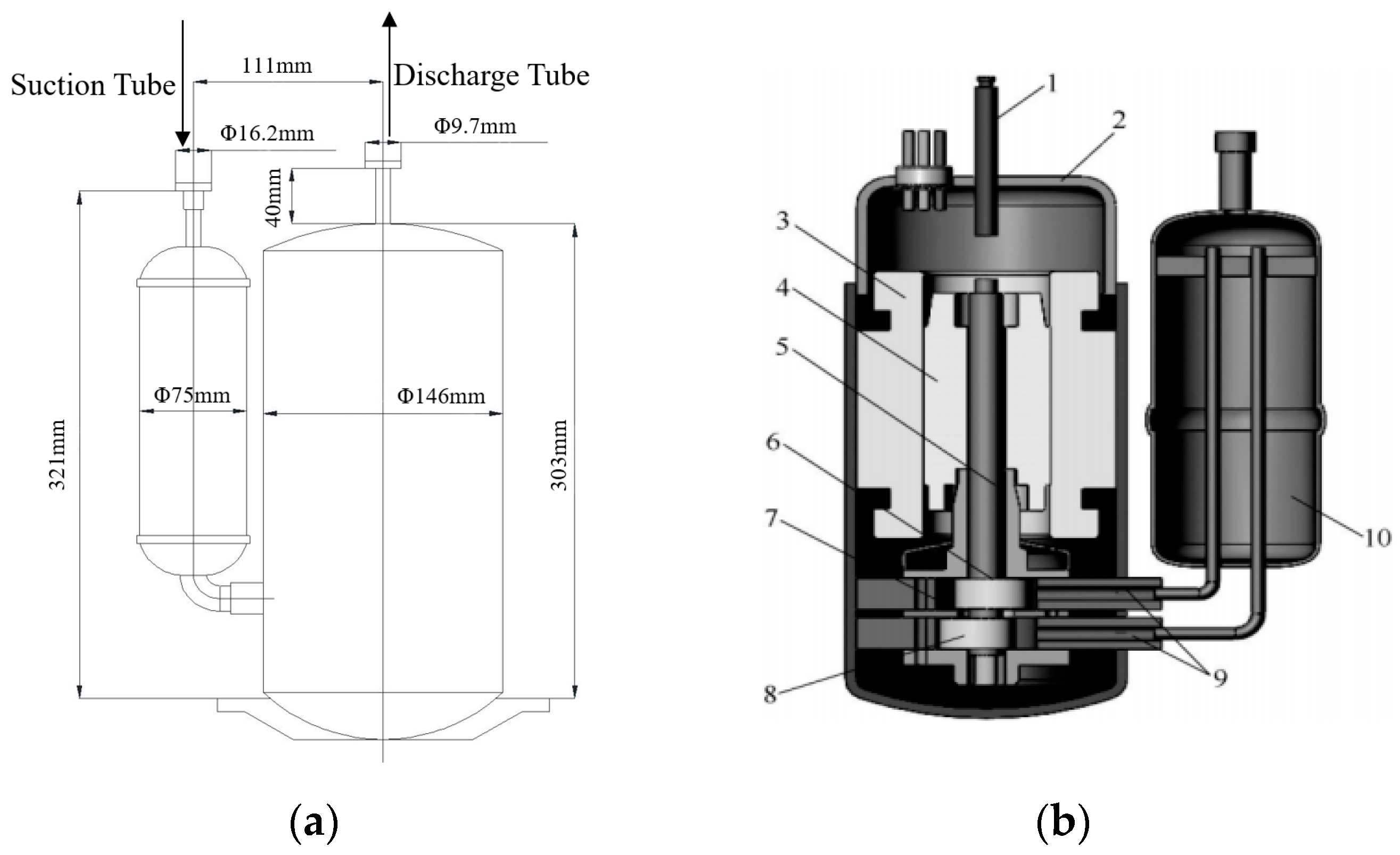

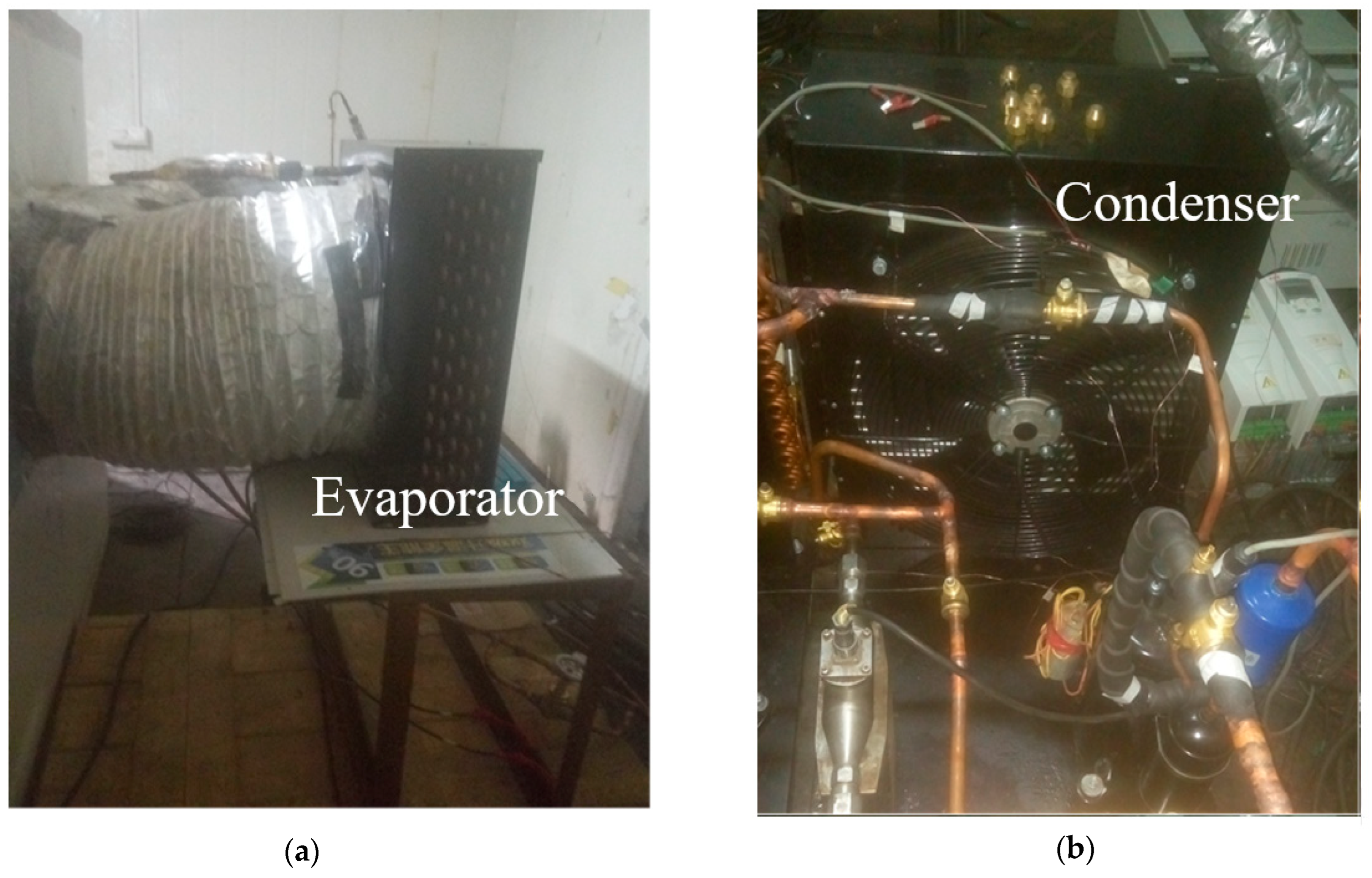
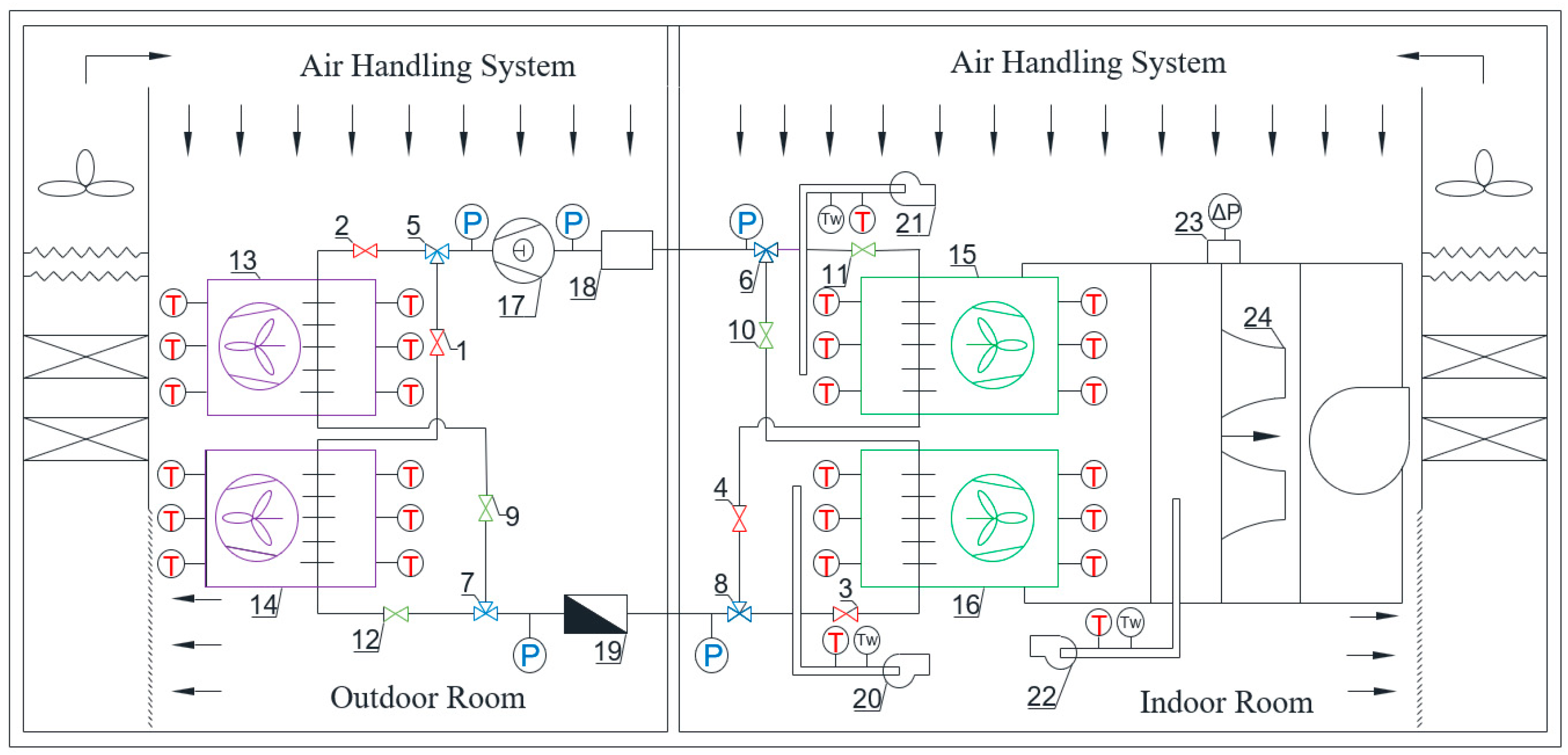
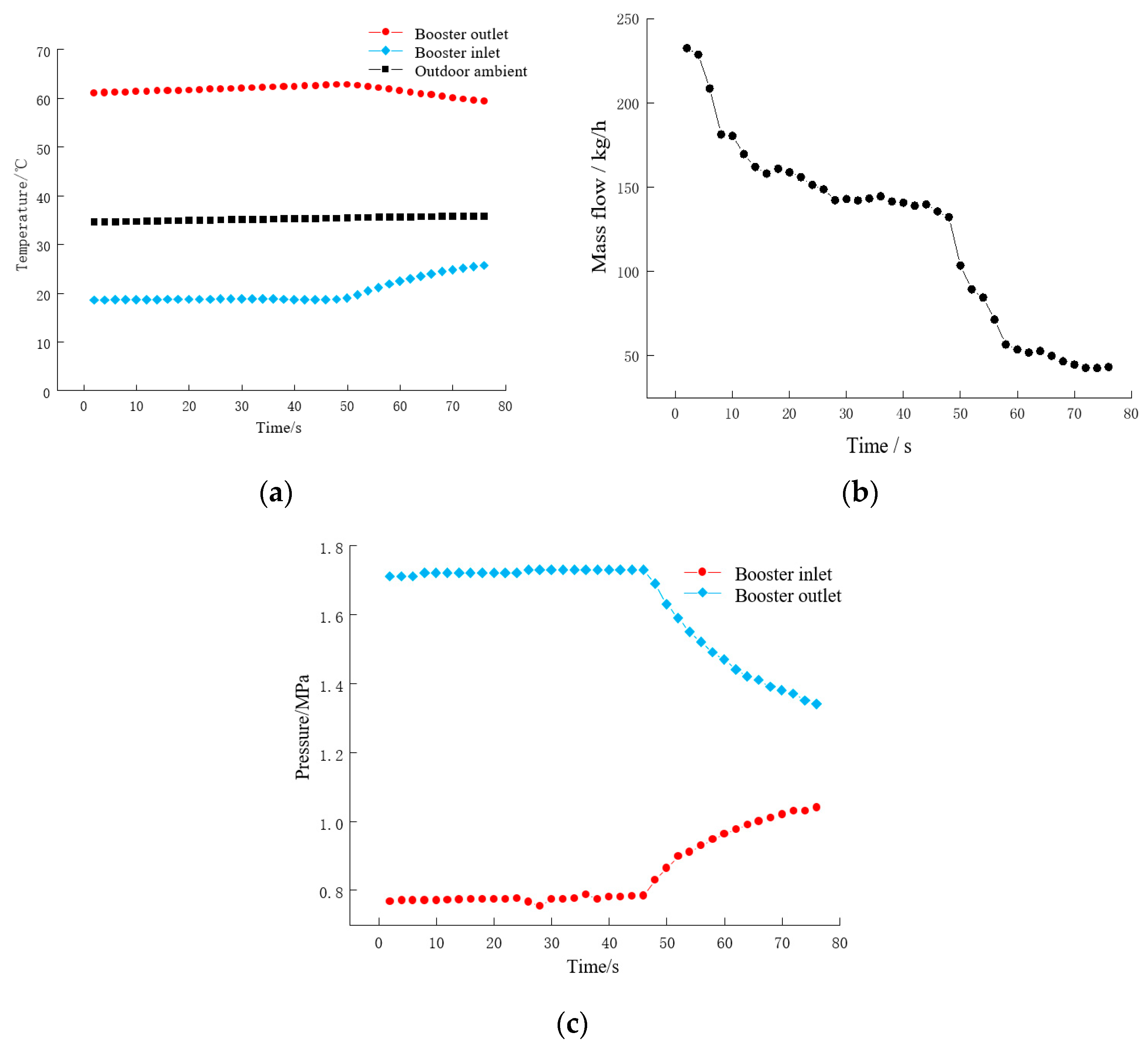


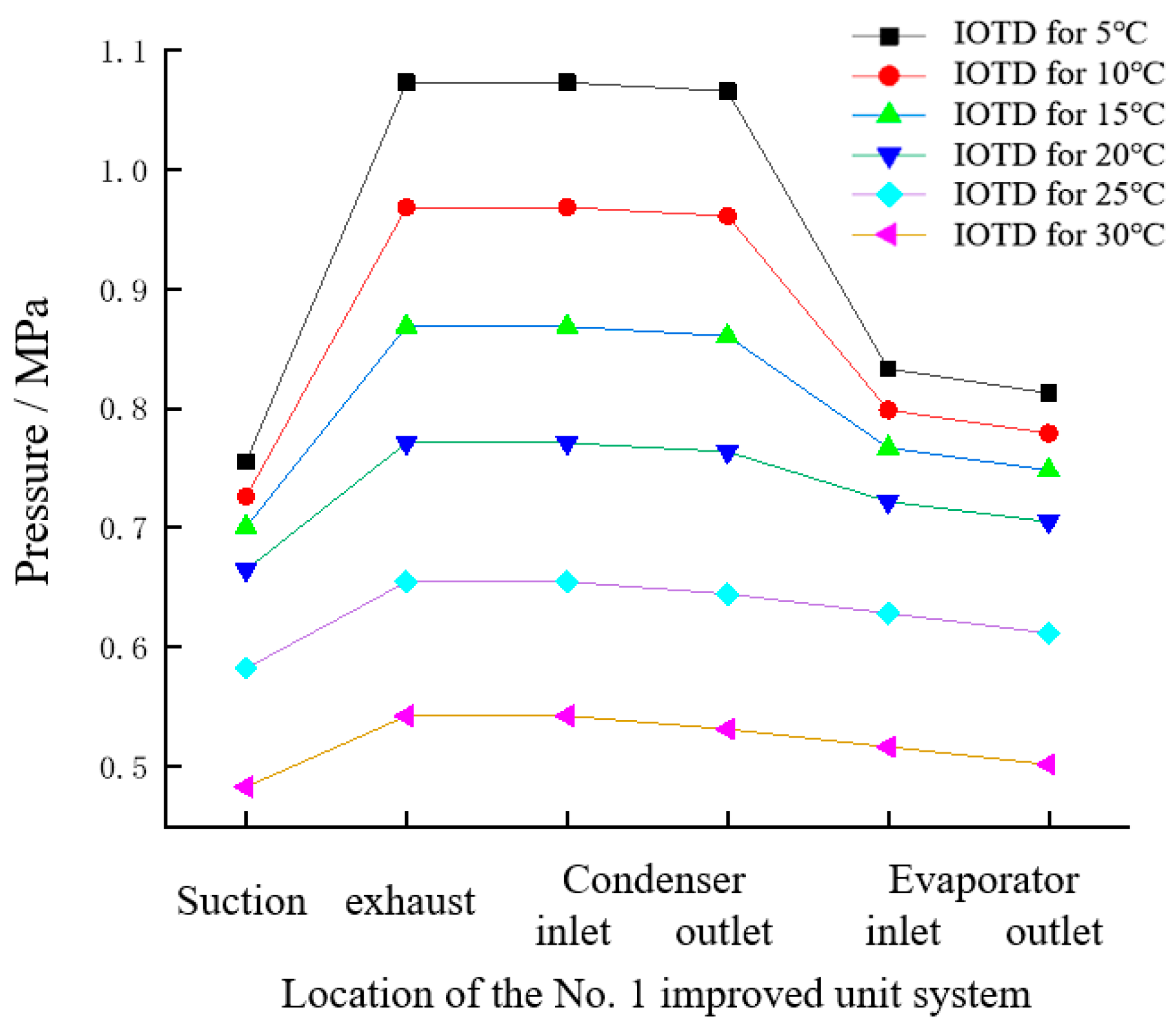
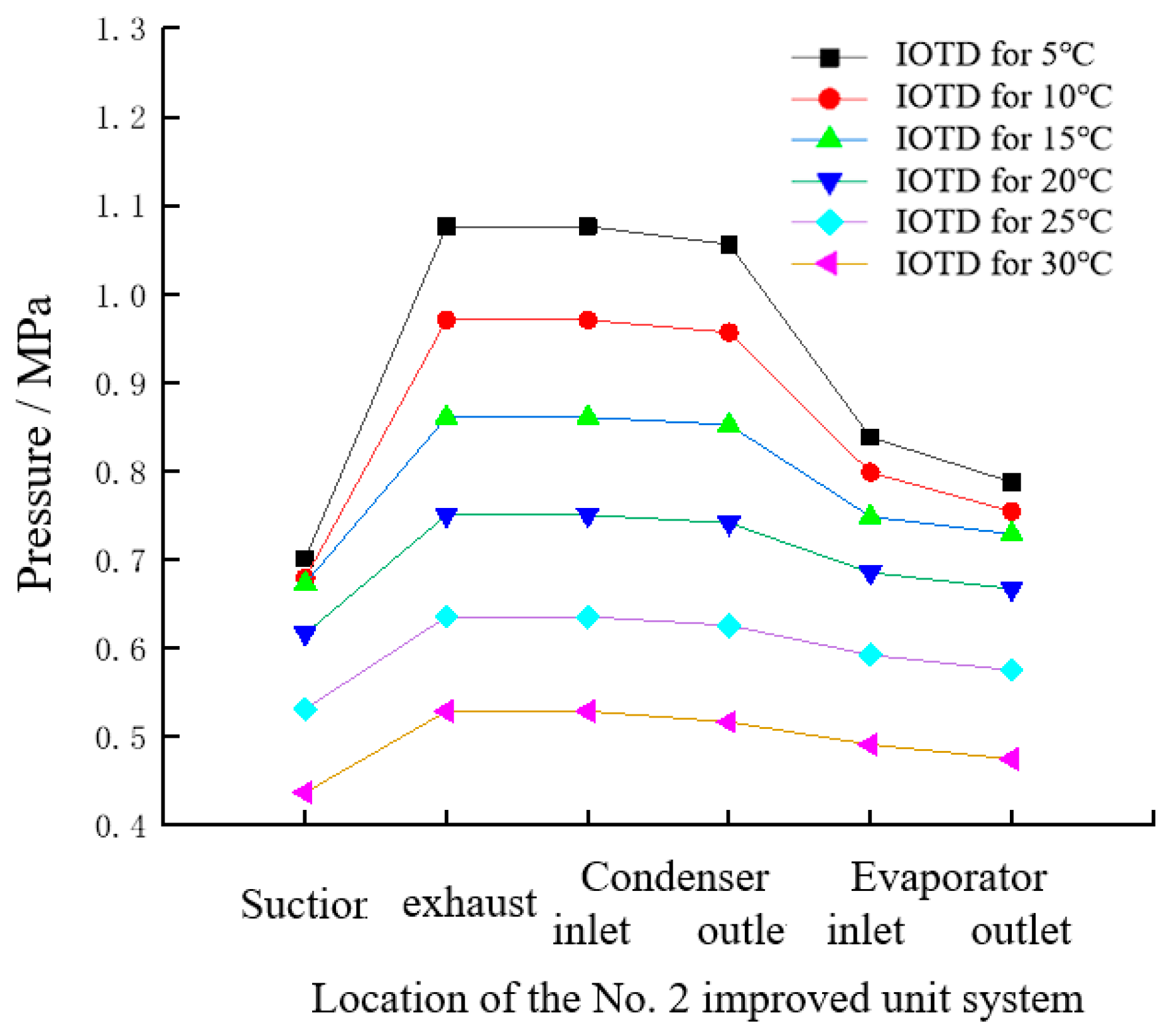
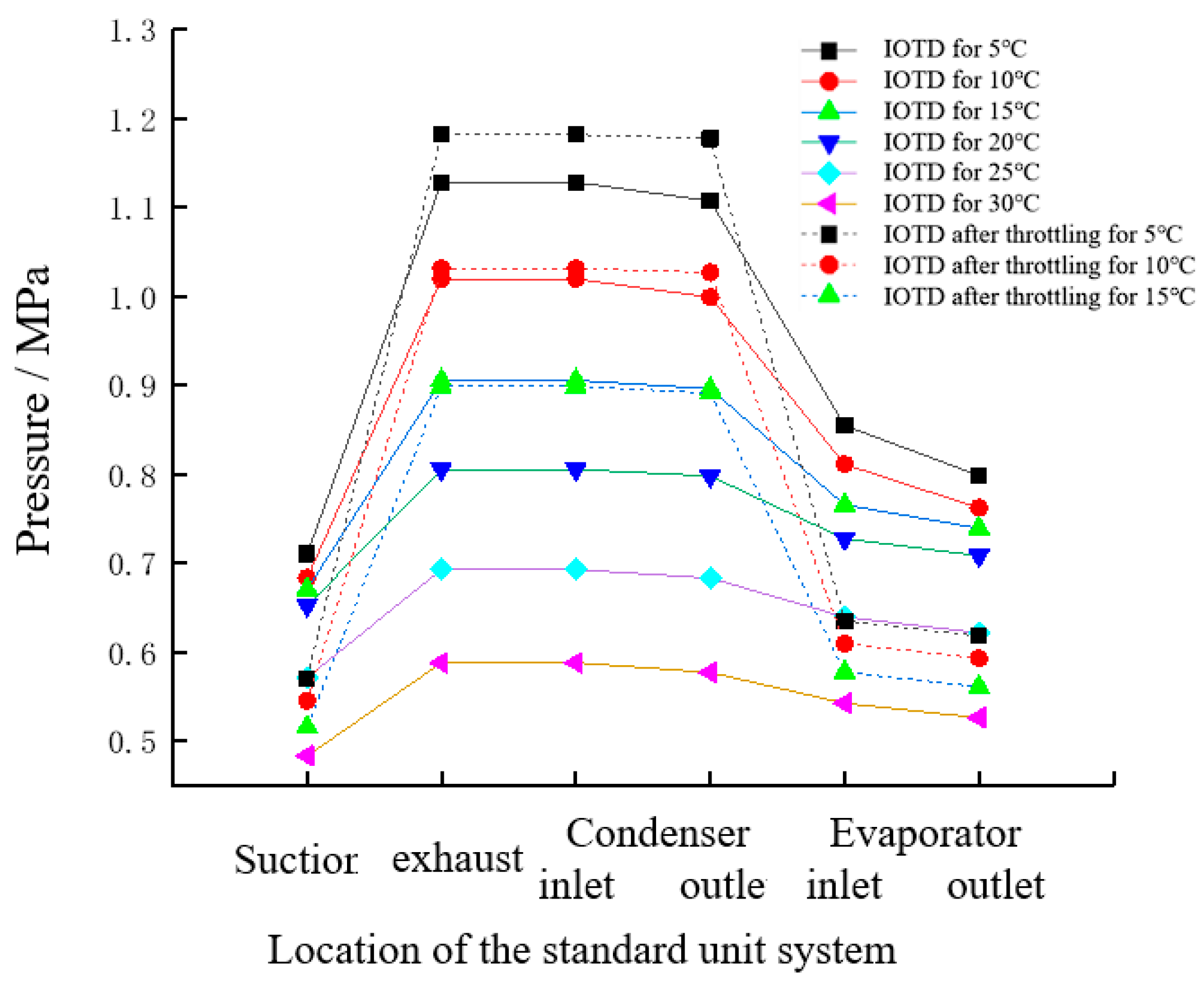
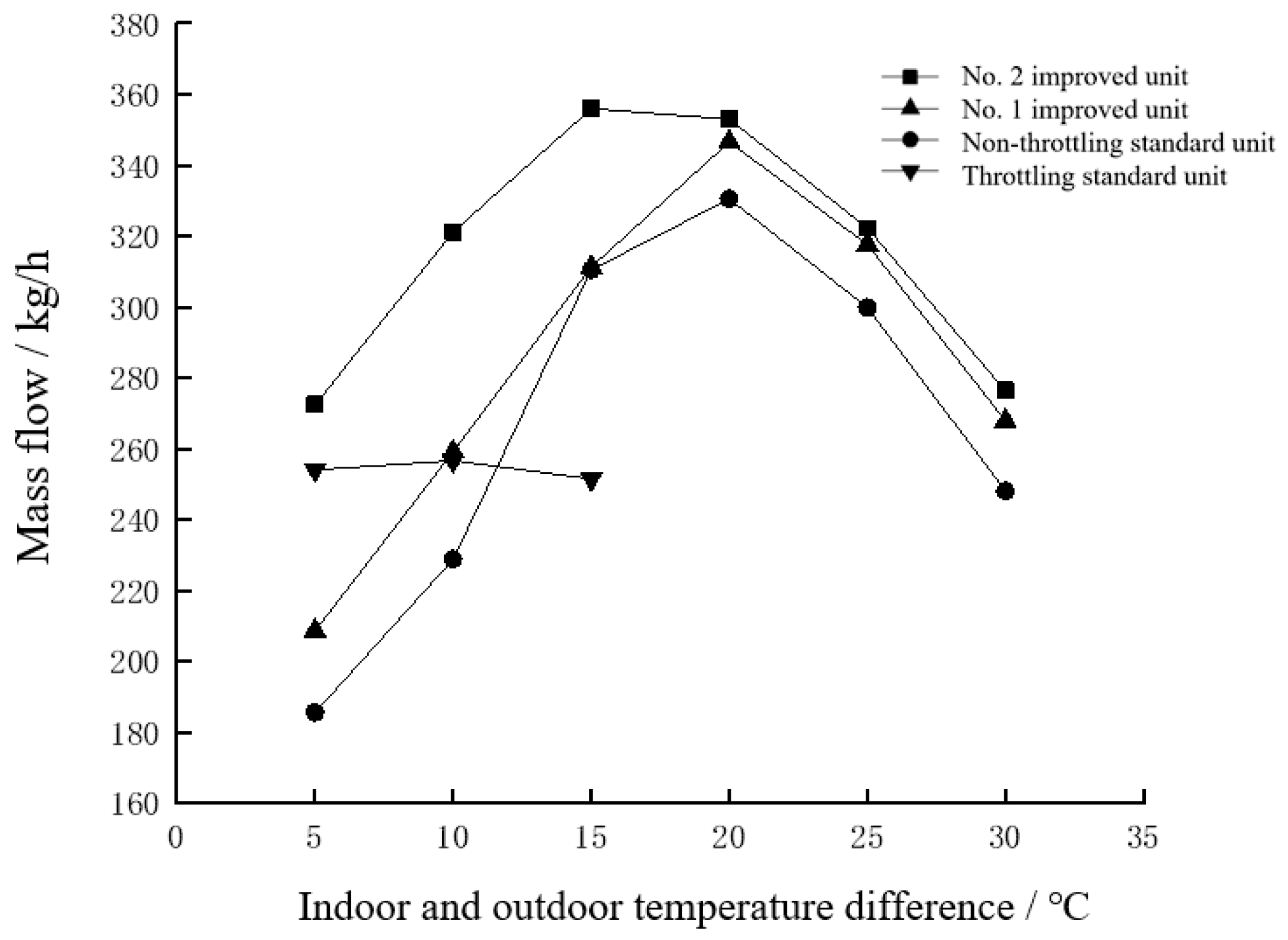
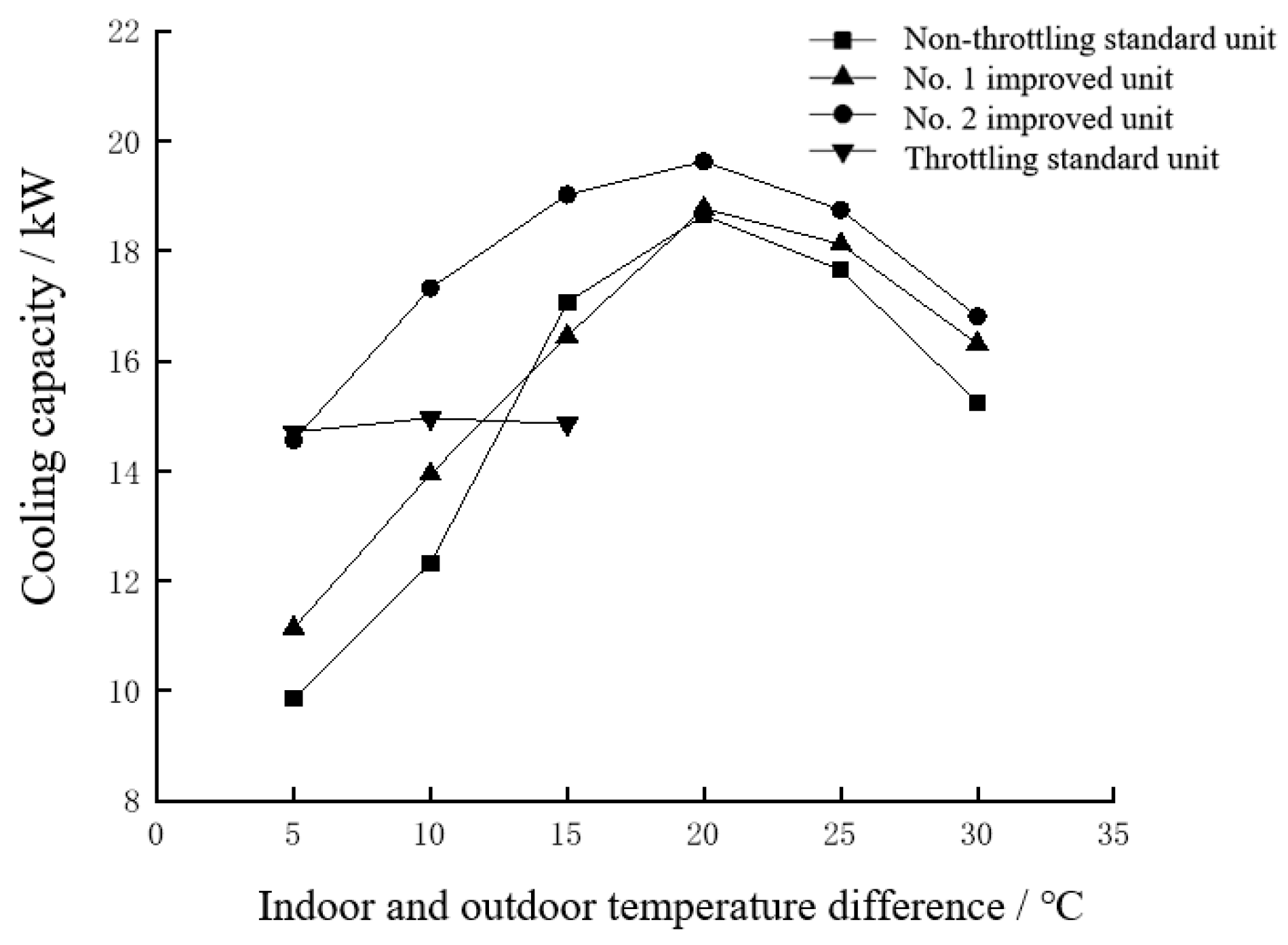
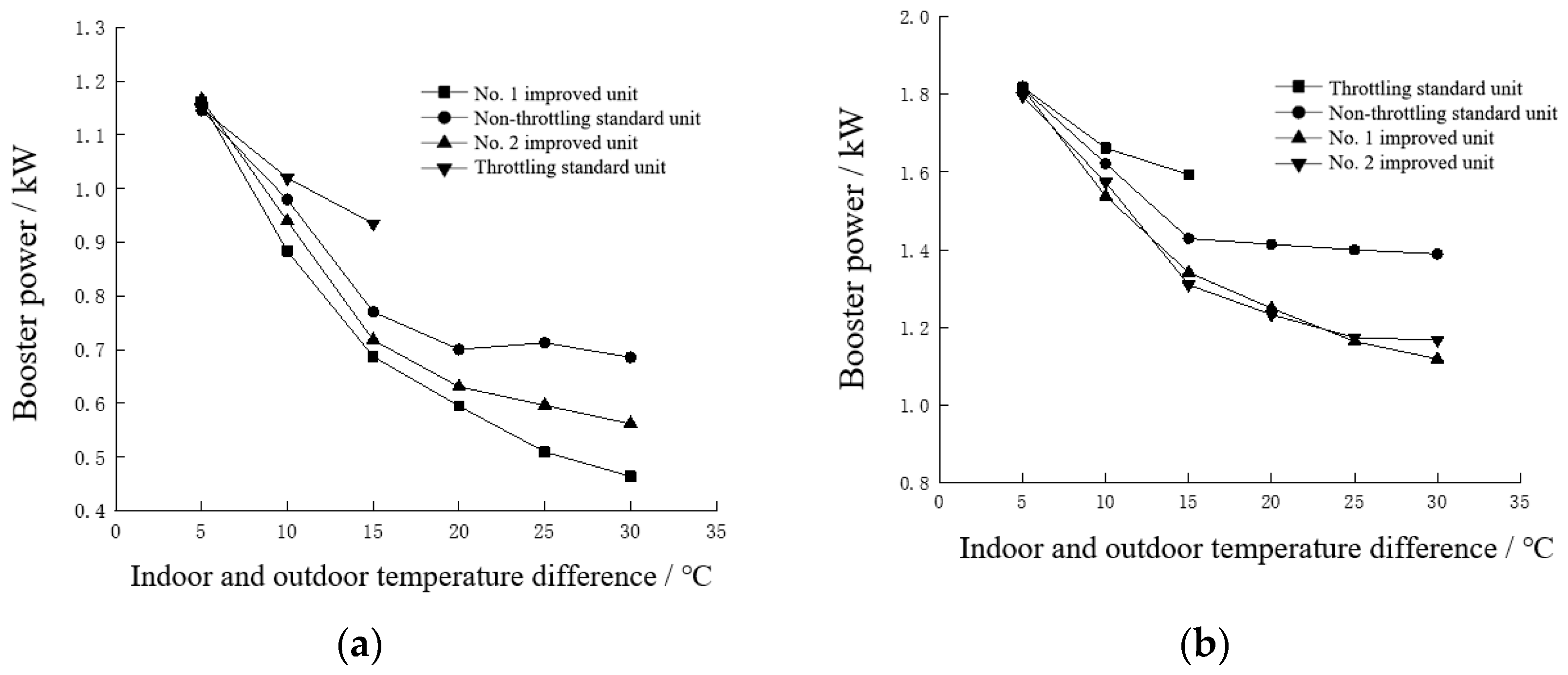

| Parameter | Symbol | Value | Unit |
|---|---|---|---|
| Outer tube diameter | do | 10 | mm |
| Tube thickness | δt | 0.5 | mm |
| Inner tube diameter | di | 9 | mm |
| Tube length | l | 500 | mm |
| Number of tube rows on the windward side | nx | 24 | / |
| Number of tube rows in the airflow direction | ny | 5 | / |
| Center distance between tubes on the windward side | sx | 25 | mm |
| Pipe center distance in the airflow direction | sy | 22 | mm |
| Fin thickness | δf | 0.2 | mm |
| Fin spacing | sf | 2.3 | mm |
| Instrumentation | Precision | Range | Brand/Model |
|---|---|---|---|
| Thermocouples | ±0.2 °C | −30 °C–150 °C | Omega/TT-T |
| Pressure transducer | ±0.2% | 0–25 bar | Huba/YD512 |
| Data logger | —— | —— | Agilent/34970A |
| Power monitor | ±0.02% | —— | YOKOGAWA/WT230 |
| Pressure difference transducer | ±0.25% | 1000 pa | EJA-120/110 |
| RTD platinum resistance | A class | 0.00–60.00 °C | NRHS3/3wire |
| Mass flow meter | ±0.2% | 500 kg/h | BJSINCERITY/Ultrasound Mass flow meter |
Disclaimer/Publisher’s Note: The statements, opinions and data contained in all publications are solely those of the individual author(s) and contributor(s) and not of MDPI and/or the editor(s). MDPI and/or the editor(s) disclaim responsibility for any injury to people or property resulting from any ideas, methods, instructions or products referred to in the content. |
© 2023 by the authors. Licensee MDPI, Basel, Switzerland. This article is an open access article distributed under the terms and conditions of the Creative Commons Attribution (CC BY) license (https://creativecommons.org/licenses/by/4.0/).
Share and Cite
Zhuang, R.; Zhou, F.; Tian, X.; Xu, B.; Li, S.; Ma, G. Performance Study of Booster-Driven Hybrid Cooling Units for Free Cooling in Data Centers. Sustainability 2023, 15, 14558. https://doi.org/10.3390/su151914558
Zhuang R, Zhou F, Tian X, Xu B, Li S, Ma G. Performance Study of Booster-Driven Hybrid Cooling Units for Free Cooling in Data Centers. Sustainability. 2023; 15(19):14558. https://doi.org/10.3390/su151914558
Chicago/Turabian StyleZhuang, Rong, Feng Zhou, Xuwen Tian, Buqing Xu, Shaocong Li, and Guoyuan Ma. 2023. "Performance Study of Booster-Driven Hybrid Cooling Units for Free Cooling in Data Centers" Sustainability 15, no. 19: 14558. https://doi.org/10.3390/su151914558




